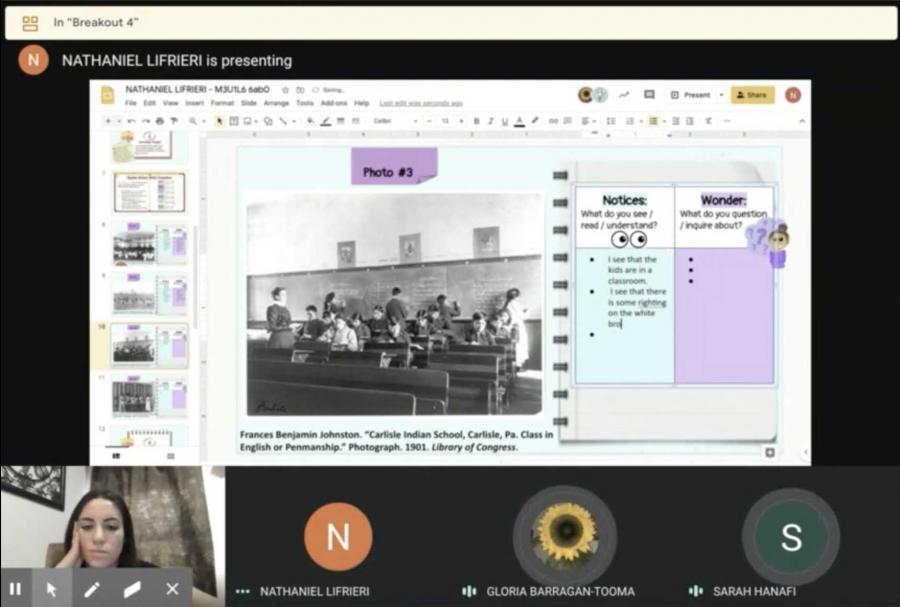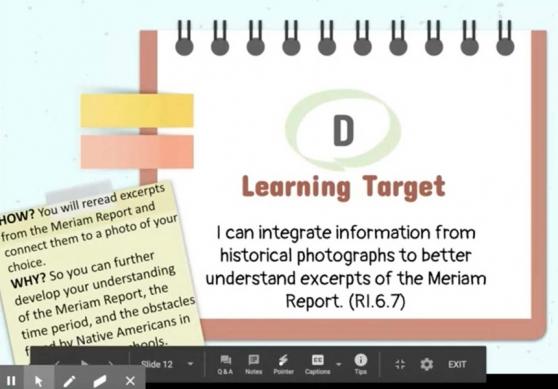
Alyssa Stalzer, a 6th-grade ELA teacher at PS/IS 30 in Brooklyn, uses digital tools to help her students collaborate in real time while learning remotely.
The idea of teaching remotely was “unexpected and terrifying” at first to Alyssa Stalzer, who was in her second year of teaching 6th- and 7th-grade ELA at PS/IS 30 in Bay Ridge, Brooklyn, when the pandemic forced school buildings to close.
But nearly a year later, Stalzer is surprised to find herself describing remote teaching as “a beautiful adventure.”
“I’ve chosen to look at it as an opportunity to change the way we perceive education,” she says.
There’s no doubt remote teaching can be challenging, exhausting and less than ideal. But with months of remote teaching now under our belts, there are some surprising takeaways teachers can use to make remote instruction more effective.
1. Digital games are entertaining, but they need to be thoughtfully incorporated into learning in small doses.
Online platforms like Quizzizz and Kahoot, which allow students to play educational games and compete to earn points on learning quizzes, have inspired some teachers to “gamify” instruction and assessment. Quizzizz advertises itself as “fun and engaging,” while Kahoot says its mission is to “make learning awesome!”
In an EdWeek Research Center survey conducted in late 2020, 62% of teachers reported that they were incorporating more digital games designed for educational use into their lessons. But only a quarter of the middle and high school students surveyed agreed that the games made learning more interesting.

In Stalzer’s remote classroom, the most helpful digital tools replicate familiar experiences for her students.
Richard Van Eck, a researcher who studies educational games, suggests that “one reason students might not value the games they are playing at school could be that educators are haphazardly integrating games into learning without strategizing first,” according to EdWeek.
It doesn’t mean teachers shouldn’t try to inject a little levity into their instruction. But teachers can raise students’ spirits by organizing experiences that involve not just screen time but socialization.
“Making time for games as a class at the end of the day has probably been the most successful part of remote teaching, because these kids are craving social interactions,” says Amy Crehore, a 5th-grade dual language teacher at Samara Community School in the Bronx.
Games can also motivate students to complete independent work. “Games serve as incentives for students to do asynchronous work — if they’ve missed work, they can complete it in a breakout room and then come back to the main room to play when they’re done.”
2. Digital tools may work best when they replicate familiar experiences.
Some educators enjoy using innovative devices like Bitmoji to make their digital classrooms feel flashy and fun. But some teachers find that the tools they most frequently rely on are the ones that allow them to respond to and collaborate with students in real time — the same way they may have used anchor charts, Post-it notes or exit tickets in the classroom.
“I looked and looked online for resources about how to have students do peer reviews remotely, and there were so many,” says Stalzer. “But I ended up simply partnering students in breakout rooms and having them look at the same Google Doc. Sometimes less is more.”
Stalzer uses the chat feature in her virtual meetings for a “waterfall” discussion activity: Students have two minutes to type their answer to a question in the chat, but they don’t hit “enter” until the timer goes off.
“Their responses look like a waterfall in the chat,” she says. “Everyone has a chance to answer in their own words, and everyone has a voice.”
3. Students may be “digital natives,” but many still need to be taught how to use digital tools.
A 2018 Pew Research Center survey found that more than half of children use tablets, computers, smartphones and gaming devices regularly. But we can’t necessarily expect that even kids who effortlessly navigate the spaceship in the popular Among Us game can guide themselves through remote learning with the same ease.
Jillian Ehlers, a librarian at the Metropolitan Expeditionary Learning School in Forest Hills, Queens, recalls reading students’ emails with dismay: One email was in all capital letters. Another contained the entire body of the email in the subject line.
So Ehlers devised a series of tutorials for students on activities like composing an email and using Google Documents.
“Students are hungry for these digital skills,” she says.
4. Remote rewards are still rewarding.
“We still have those students who need stickers or tokens in remote classrooms,” says Monica Iacono, a special education teacher and the UFT Teacher Center site coordinator at PS 60 on Staten Island.
Iacono worked with teachers at her school to develop a “bank of motivators” for remote classrooms that revolve around giving students choices and opportunities — activities like getting to choose the class read-aloud for the day or a favorite movement break.
“We thought carefully about how to deliver those positive reinforcements, because we still have to motivate children,” she says.